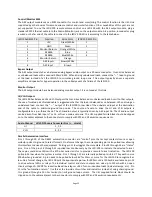
Page 38
19.
Use the rear panel trim pots to adjust the low, mid, and high band gains as required for a relatively flat
response as shown on the RTA. Remember that the front panel fader also adjusts the overall output level, so it
may be necessary to adjust that control up.
20.
Take the system out of bypass by pressing the Bypass button on the X-Overs tab again.
7.5.2
Auditorium Equalization
The JSD-100 allows auditorium equalization to be completed automatically or manually using its precision internal
RTA.
7.5.2.1 Automatic Equalization
1.
Connect four microphones to a microphone multiplexer such as the USL MMP-10. Position the microphones as
specified in SMPTE 202-2010 sections 5.2 and 5.3.
2.
Connect the microphone multiplexer output to the CAL or PA microphone input of the JSD-100.
3.
On the Equalizer tab, select the CAL or PA microphone as appropriate.
4.
On the Equalizer tab, press the Curve File button and select the appropriate curve file (such as x-curve 150
seats.ini). This sets the limit lines on the RTA display.
5.
Press Mic File to load a previously generated microphone calibration file, or calibrate the microphones as
described below:
a.
On the equalizer tab, select the center channel.
b.
Set the gain control at the far left of the equalizer to minimum.
c.
Set the main fader to 0.0.
d.
Press the Flatten button.
e.
Press Pink and Generator to drive the center channel with pink noise.
f.
Adjust the main fader towards 7.0 without exceeding 85dB SPL in the auditorium.
g.
Adjust the gain control at the far left of the equalizer tab to yield 85dB SPL in the auditorium.
h.
Press the Mic Cal button to bring up the microphone calibration dialog box.
i.
Adjust the Microphone Gain control in the microphone calibration dialog box until the JSD SPL agrees with
the reference SPL meter.
j.
If desired, press the Save button to save this microphone calibration in a file. The use of the microphone
model number and serial number(s) as a filename is suggested.
k.
Press the Generator button again to turn off the generator.
6.
Press Auto EQ to automatically equalize this channel. The Auto EQ sequence will put up messages showing the
progress of the equalization.
7.
Select the next channel to be equalized and press Auto EQ again. Repeat this until all channels are equalized.
7.5.2.2 Manual Equalization
A suggested procedure for equalizing a channel is listed below. You theater may use a modified or different
procedure. If an external pink noise generator is to be used with the internal RTA, enable the internal pink noise
generator, then disable it. Enabling the internal pink noise generator configures the internal RTA for proper
operation.
1.
Connect four microphones to a microphone multiplexer such as the USL MMP-10. Position the microphones as
specified in SMPTE 202-2010 sections 5.2 and 5.3.
2.
Connect the microphone multiplexer output to the CAL or PA microphone input of the JSD-100.
3.
On the Equalizer tab, select the CAP or PA microphone as appropriate.
4.
On the Equalizer tab, press the Curve File button and select the appropriate curve file (such as x-curve 150
seats.ini). This sets the limit lines on the RTA display.
5.
Press Mic File to load a previously generated microphone calibration file, or calibrate the microphones as
described below:
a.
On the equalizer tab, select the center channel.
b.
Set the gain control at the far left of the equalizer to minimum.
c.
Set the main fader to 0.0.






























